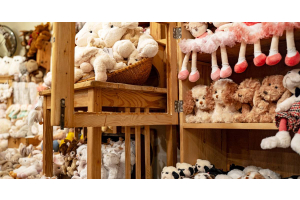
Whether you’re looking to start a fundraiser, set up a school-wide competition, or simply encourage good behavior in the classroom, school reward systems are a great way to incentivize students. Children are more likely to participate in school events when they can earn a physical reward.
Implementing a reward program will motivate students without discouraging others. If you want to set up a school reward system, follow these dos and don’ts to benefit your school.
Do Focus on Positive Reinforcement


When you reward good behavior, you create a supportive learning environment for the kids. Their minds will slowly correlate rewards with good behavior. Build the foundation of positive reinforcement while keeping the following aspects in mind.
Offer a Variety of Rewards
As you build your reward system, include a variety of items to appeal to the general population of your school. Some may respond well to tangible rewards like stickers or small prizes, while others might appreciate privileges like extra recess time or the chance to lead an activity. With a variety of rewards, everyone can earn something special from good behavior.
Also, give your students the option to choose the reward they receive. Have the student stop by the front office to pick out a toy, sticker, or voucher. Fill the reward system with wholesale incentives like children’s light-up toys to motivate them at school.
Personalize the Rewards
Get to know your students and tailor rewards to their personal interests, like catering to both artsy and sporty kids with a coloring book and small football. Personalization shows students that you recognize and appreciate their unique qualities, which makes the reward system more effective.
Teachers know their students well; ask fellow staff members for details on what rewards their classes would like. They’ll provide insights into the latest trends the children love.
Recognize Effort and Improvement
Rewards systems work well for overachievers, but they should also support those who are gradually improving in their work. Applaud the students who are resilient and work hard to overcome challenges.
For example, a student might have a hard time with a certain subject in school, but they’re showing improvement. Acknowledge their hard work with a reward to boost their confidence and encourage further progress.
Do Establish Clear Criteria for Rewards
When you set up a school reward system, establish transparent criteria for children to redeem rewards. This is especially important for fundraisers or school-wide events that involve the parents. Prevent confusion and communicate the requirements for the reward system to students, family, and staff.
Set Specific Goals
Define clear, achievable goals that students need to meet to receive rewards. Instead of vague criteria like “good behavior,” specify what it entails. Good behavior could equate to completing homework on time for a week, helping a classmate, or improving their scores on homework and quizzes.
For school-wide events, set tier lists for going above and beyond the goals. If you’re hosting a fundraiser for your school, create contribution objectives and reward the students who achieve specific goals. This way, there is an incentive to achieve the highest goals on the list.
Communicate the Criteria to Students
Make sure students, staff, and parents are fully aware of the reward system criteria. Communicate these criteria through classroom discussions, posters, or newsletters. With these reminders, everyone will stay informed about the system and encourage others to follow the guidelines.
Consistently Follow the Criteria
Consistency for administering rewards will keep the system fair and uniform for all students. If staff members make exceptions, it could lead to perceptions of favoritism or unfairness, which could undermine the system and have the opposite effect on what you want to achieve.
Set the guidelines with flexibility in the rulings but avoid making exceptions for lackluster effort. If students feel frustrated after not meeting these goals, calmly remind them of the rules they must follow to earn a prize. Mitigate issues by staying consistent with the approach.
Don’t Rely Solely on Material Rewards


While material rewards can be motivating, relying on them can diminish intrinsic motivation. Students may force good behavior to receive a reward and then revert to their previous behavior after receiving the toy or game. Focus on reinforcing this behavior by being encouraging but limiting in your reward system.
Encourage Intrinsic Motivation
Intrinsic motivation refers to someone who feels motivated to achieve something because they feel inspired to do so. Encourage students to find joy in the learning process itself rather than just the end reward.
For example, celebrate students’ exploration and curiosity during a science project. Let them learn to enjoy the process and explore their passions with positive reinforcement.
Use Praise and Recognition
Praise and verbal recognition are powerful tools that can be just as effective as material rewards. Acknowledge a student’s effort in front of their peers or write a personalized note recognizing their accomplishments.
These praises are especially important if they fall just short of the requirements in the reward system. Students might feel demoralized if they don’t receive a material reward. Nevertheless, kind words can inspire them to strive for greatness.
Limit Frequency of Material Rewards
Use material rewards as a complement to other forms of recognition, not as the sole motivator. Instead of daily rewards, consider weekly or monthly recognition for sustained effort. This makes it feel more rewarding for the kids by incentivizing them to maintain good behavior or work ethic for long periods of time.
Don’t Create Unhealthy Competition
A reward system that fosters unhealthy competition can lead to negative consequences like anxiety or resentment. Avoid emotional outbursts by implementing the following qualities into the school reward system.
Focus on Personal Growth
Encourage students to compete against their past performance rather than against other students. This way, no one is left behind in the reward system. Highlight personal growth and self-improvement to foster a supportive environment where students cheer each other on.
Promote Teamwork and Collaboration
Structure some of the goals around teamwork and collaboration to emphasize group success. For example, reward a group of students who work together to complete a project or help each other study for a test. Establishing collaborative goals reinforces the idea that working together can lead to great achievements.
Avoid Public Comparisons
Refrain from publicly comparing students’ achievements or rankings. Comparison can create feelings of inadequacy or resentment. The best approach is to focus on individual accomplishments privately or within small groups so no students feel discouraged from participating.
As you plan your next school-wide event, consider how a reward system can help you achieve many important goals. This system builds participation, motivates students, and provides lifelong benefits. Use the system to encourage students to be kind and succeed by praising their amazing efforts.






